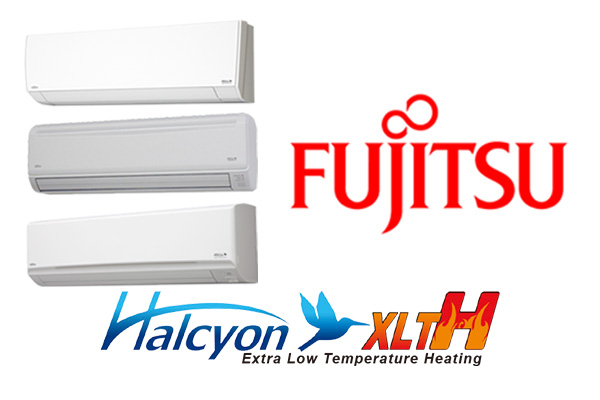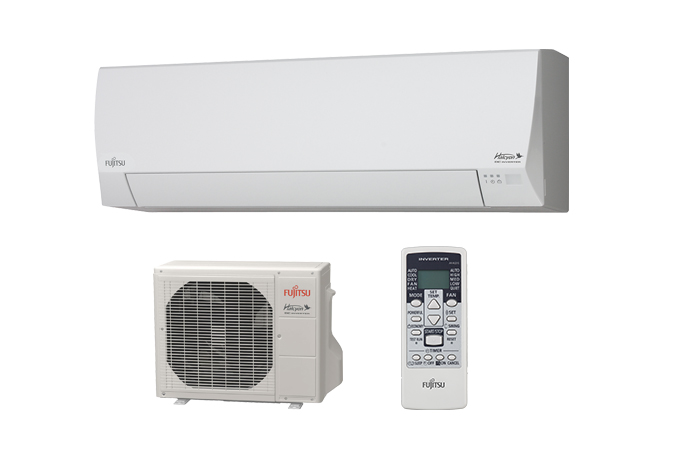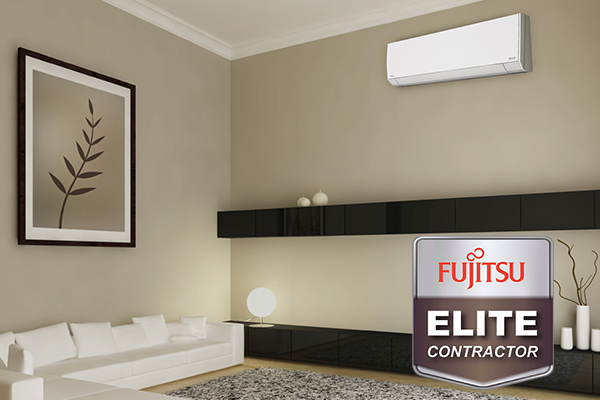Exploring The Wall-Mounted Ductless System
Ductless mini-splits come in various types, designs, and sizes. Some kinds of mini-splits include the floor-mounted, wall-mounted, ceiling cassette, ceiling suspended, and floor standing. A wall-mounted ductless system is typically the easiest to install and the least expensive of the mini-splits on the market. They are also the ideal HVAC system for most types of rooms. It is for these reasons that wall-mounted units are often the go-to option for many homeowners when it comes to indoor mini-split systems.
What Is A Wall-Mounted Ductless Unit?
Contents
The heating and cooling process of a wall-mounted ductless unit is much like any other HVAC unit. Unlike a window A/C, however, the ductless unit has one part of the unit that is completely outside of the home. The condenser coils, vent fan, and compressor are in a self-contained unit outside of your home. Whereas, the evaporator coils and blower are in the air handler inside. A conduit line that passes through a three-inch hole in the wall connects these two components.
An HVAC contractor installs the indoor air handlers of a wall-mounted heating and cooling system high up on a wall. One wall-mounted indoor unit can typically only heat or cool one room since it pumps conditioned air directly into it. They come in different styles to suit your interior design. Some have low-profile designs, while you can hide others behind a picture frame.
Features Of A Wall-Mounted Unit
Wall-mounted ductless systems offer a variety of features that provide optimal comfort, control, efficiency, and performance. Here are some of the critical features wall units have:
Sophisticated Design
Many wall-mounted systems have a sleek and slim design. They have an elegant front panel that can be professionally wrapped or painted so that they’ll blend into your interior design. Rest assured that both outdoor and indoor units undergo a rigorous durability testing. This ensures that wall-mounted units not only have a modern design as they are built to last as well.
Comfort Control
Return air sensors are installed in every unit allow your wall-mounted system to monitor room conditions accurately. These sensors alert the rest of the unit so that it can adjust the settings to ensure that the temperature remains at a consistent level. Some units also have infrared technology, which scans the room to check for human heat signatures. It then adjusts the settings based on whether or not the room is occupied or not.
Advanced Air Filtration
Wall-mounted systems are equipped with washable multi-stage allergen filtration. These trap dust, contaminants, allergens, and other particulates. As a result, you can breathe easy knowing that you have high indoor air quality in your home.
Remote Control
Wall-mounted units can be controlled by a standard handheld remote controller or via an app on your smartphone or tablet. You can choose which one best suits your preferences and lifestyle. This way, you can manage your wall-mounted ductless system well and use it to the best of its capabilities.
The Pros And Cons Of A Wall-Mounted Ductless Unit
If you are considering installing a wall-mounted HVAC in your home, it is recommended that you first understand its advantages and disadvantages. This way, you can determine if the wall-mounted is the system for you.
Advantages
Some of the pros of a wall-mounted unit include:
- Energy-efficient: A significant advantage of a wall-mounted unit is its energy-efficiency. It is equipped with advanced technology, such as variable fan speeds. These different speeds ensure that you do not waste energy without compromising your comfort. Your household becomes more cost-effective this way, while helping the environment as well.
- Versatile application: Wall-mounted units do not require ductwork. Therefore, they are an excellent choice for any kind of building. This includes apartments, offices, single-family homes, and condominiums. They also do not block the view, as a window unit does.
- Easy to install: The installation of a ductless wall-mounted unit typically lasts for only a few hours, depending on the number of indoor units your house requires. This is because the process is less invasive, unlike a traditional HVAC system that requires the installation of ductwork.
- Improved air quality: Ductwork accumulates dust, pollutants, and other contaminants over time. Because a wall-mounted unit doesn’t need ductwork, you eliminate the risk of having dirty ductwork that may circulate these indoor air pollutants in your house. Wall-mounted units are also equipped with air filters so that you experience better indoor air quality.
Disadvantages
Like any other machine, a wall-mounted system also has some disadvantages. Here are a few:
- Initial ductless cost: Compared to a window unit, a wall-mounted ductless unit costs a bit more to install. This is especially true if you have a large house that requires more units. For homes that have multiple zones, an HVAC contractor will need to install one indoor air handler per zone. While the initial cost may be a bit costly, a wall-mounted unit saves you more in the long run.
- Placement can be tricky: The wall-mounted unit needs to be appropriately placed. If it is mounted in the wrong spot, then the unit can end up performing poorly. For instance, if you put it in a corner that gets direct sunlight, then the sensors will inaccurately read the indoor temperature. As a result, it won’t be able to provide you with the thermal comfort you require. A professional technician will be able to help you find the best place for your wall-mounted unit.
- Aesthetic appeal: The air handlers of a wall-mounted ductless unit are visible in the room. Some homeowners, especially those that highly value aesthetics, dislike the obtrusive look of a wall-mounted unit.
When To Choose A Wall-Mounted Ductless System
A wall-mounted mini-split can cool and heat an average-sized room that has ceilings that are at least seven to eight feet high. Common rooms that use wall-mounted ductless systems include bedrooms, living rooms, dining rooms, and small offices. The unit needs to be mounted at least six feet high on the wall so that it can evenly distribute the conditioned air in the room. If you want to heat or cool places with low or slanted ceilings, such as an attic, then this might not be the type of HVAC unit for you. A floor-mounted system might be better suited if this is the case.
If you are planning to install wall units in a larger room, then you might need to install several units. This will ensure that you achieve your desired comfort level. Multiple units that are spread evenly throughout the room will make sure that there are no hot or cold spots. Otherwise, you can choose to install a different type of mini-split that has more coverage like a ceiling suspended unit or a ceiling cassette.
Installing A Wall-Mounted Mini-Split
Before buying a wall-mounted mini-split, check the specifications on wall depth. Different makes and models have different wall depth sizes. Not checking the wall depth specification of the unit you’ll purchase might lead to a unit that won’t fit in your wall. Keep in mind that some walls might be too thick for some units.
Each wall-mounted unit comes with a lightweight wall bracket that must be adequately attached to the wall first. After the bracket is secured, the wall unit is hung on the bracket. Make sure that the wall unit is mounted horizontally and not diagonally or vertically. Otherwise, the unit won’t be able to operate correctly.
Vertical Surface
Moreover, an HVAC contractor should place the unit on a vertical surface as wall units will not work correctly on a sloped wall like the ceiling of an attic room. The ceiling must be high enough that the system can be placed at least six feet high on the wall. Check the manufacturer’s specifications on the suggested space between the ceiling and the unit so that there is proper airflow.
Exterior Wall
Experts highly recommend that the mini-split indoor unit be installed on an exterior wall. This will make the installation and drainage a lot easier. Placing it against an outer wall allows you to run the line set, connecting wire, and drain tubing directly from the compressor to the indoor air handler via a three-inch wall hole. This also helps with drainage as you would no longer need a pump to remove the condensate. The condensate will drain out via the drain tube by gravity instead.
If you have no other choice but to install it on an interior wall, then make sure you also install a condensate pump. You should also install the unit away from a microwave, a television, or any other device with electromagnetic interference. This is to ensure that there is clear communication between the unit and the remote.
Keep the unit away from direct sunlight or other heat sources as well. It will affect the temperature reading of the unit and, thus, affect the output of the wall-mounted system.
Conclusion
There are many manufacturers of wall-mounted ductless systems. It can be challenging to choose the best wall unit that fits your situation and comfort needs. A professional technician will be able to assist you. They will use their experience to find the make/model that fits your budget, aesthetics, efficiency, and quality.
Check Out One Of Our Ductless Installation Projects
Fujitsu Ductless Mini-Split Replacement Project In Salisbury, Massachusetts
Call Townsend Energy For All OF Your Home Heating And Cooling Needs
If you are ready to switch to a ductless HVAC system or have more questions, call Townsend Energy today. Our experienced NATE-certified technicians will discuss your needs and requirements to help you find the best ductless HVAC system for you.
Townsend Energy is a full-service HVAC company that services residential and commercial properties throughout New England. We offer a range of heating and cooling services, including HVAC installations, repairs, tune-ups, and more. Our experienced, NATE certified professionals can find the best home heating and cooling solutions for your home while working with your budget. We aim to improve your home’s level of energy efficiency, comfort, and indoor air quality. Our work is backed by a warranty to ensure your satisfaction. We also provide free, in-home estimates. Call Townsend Energy today.
Contact us now at (800) 722-4101 to find out more!




